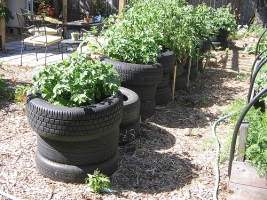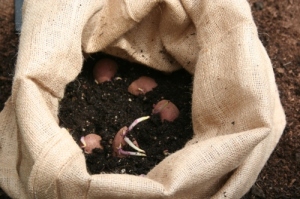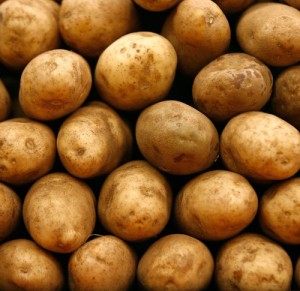This blog has moved. Please visit us at
By Kellene Bishop
Last night as I was perusing our grocery store mailers, one in particular was advertising a 10 pound bag of potatoes for one dollar. I was pretty tickled about that price. Why? Because that means I can have ONE HUNDRED POUNDS of potatoes for only 1 dollar. How? Because it’s easy to convert 10 pounds of potatoes into 100 pounds of potatoes, even if you don’t have any more space than a deck or a small patio.
It’s all about layered potato growing. Cut your potatoes into quarters. Make sure each quarter has a couple of eyes in it in about 4 inches of dirt. Be sure you don’t pat the dirt down – you want it nice and light. (As an alternative, you can use peat moss instead if you like.) You can do this at the bottom of a 55 gallon drum that has no lid, an old wooden barrel, in the middle of an old tire, or you can simply nail four 4-inch boards together forming a square. Tend to the potato plant like you would any other with sun and occasional watering. Be sure you don’t keep the soil too wet though or you will have blight.
Wait until the potato “vine” protrudes from the soil about 5-6 inches from the ground. Once it’s grown to that length, add another layer of soil, covering the growth. This will force the seedling to send out shoots underground where your potatoes actually grow. When you add another layer of dirt you can add another layer of tires or boards if you’re building it as you go. (Personally, I think using the 55 gallon dark-colored barrel is the better way to go, because it then also acts as a sort of a root cellar for the potatoes. Yes, drill a few holes at the bottom for drainage.) Continue this repeated process through your growing season. By the end of the season, you’ll have 100 pounds of potatoes in very little space. The potatoes at the bottom of your barrel will be the largest, but the ones at the top are great as well. And better yet, you know what chemicals were (or were NOT) put on the plants while they grew!
This process can be started with seed potatoes instead of the regular ones that you buy in the store, so long as you’re sure they haven’t been treated with chemicals. Keep in mind if the potatoes have been treated with chemicals, they won’t germinate. With the seed potatoes (which can be acquired from your local greenhouse), you will have a more bounteous harvest. The potatoes will grow as tall as you let them. Isn’t that just one more cool thing that we have to be grateful for?
You can leave the covered potatoes in the container during the winter until needed. Be sure to keep them covered though as the sun will aid them in becoming green and toxic. You can also “steal” some potatoes along the way as well – no need to wait until the end of the year to get some yummy potatoes! Just be sure to cover the rest of them back up once you’re done “digging” for potatoes.
My favorites are New Potatoes or any of the fingerling kinds as well as the Edsel Blue variety.
While potatoes are obviously a great source of starch, they are also a good source of vitamin C and B6, as well as potassium, manganese, tryptophan, and a few other trace minerals such as copper. Contrary to their bad rap among “low carb conscience dieters” the phenolic content of New Potatoes rivals that of broccoli, spinach, and Brussels sprouts. They are also a good fiber source, depending on how you cook them. In my opinion they taste better and are more flavorful if steamed, not boiled. When I’m making mashed potatoes, I love cooking them for just a few minutes in my pressure cooker (obviously!) and then running them through a potato ricer. YUM-MEE. They are so fluffy that way, not waxy.
Well, guess it seems pretty easy now for you to have a year’s worth of spuds!
Copyright 2009 Preparedness Pro & Kellene Bishop. All rights reserved. You are welcome to repost this information so long as it is credited to Preparedness Pro & Kellene Bishop.



No comments:
Post a Comment